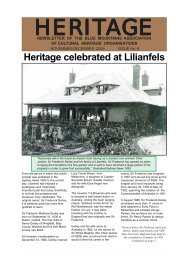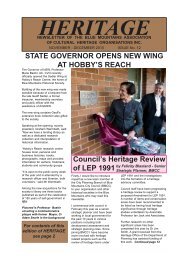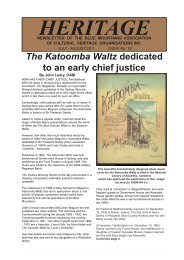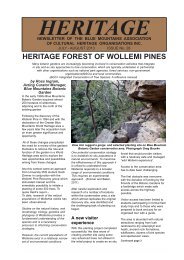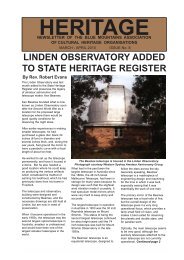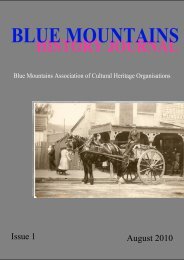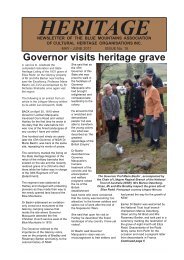Blue Mountains History Journal Issue 2
Blue Mountains History Journal Issue 2
Blue Mountains History Journal Issue 2
You also want an ePaper? Increase the reach of your titles
YUMPU automatically turns print PDFs into web optimized ePapers that Google loves.
<strong>Blue</strong> <strong>Mountains</strong> <strong>History</strong> <strong>Journal</strong> 2; 2011<br />
THE MARTINDALE FAMILY AND THE SKETCHBOOK OF MARY<br />
ELIZABETH MARTINDALE<br />
John Low<br />
39, Highland St, Leura, NSW 2780<br />
grizzlybear3au@yahoo<br />
Abstract<br />
In 1860, during a journey along the Western Road across the <strong>Blue</strong> <strong>Mountains</strong>, Mary Martindale created<br />
a series of watercolour sketches as a memento of her trip. In their modest way they depict road<br />
conditions, people and vehicles, buildings and landscape scenery. Mary was the wife of Captain Ben<br />
Hay Martindale who spent three difficult years in NSW responsible for roads, railways and the electric<br />
telegraph. Soon after this excursion Ben resigned and the family returned to England where Mary died<br />
in 1902. In 1930 her daughter donated the sketchbook to the Mitchell Library. Largely ignored, it<br />
provides a valuable impression of travel in the years before the railway.<br />
Keywords: Martindale; Western Road; travel; art; women; <strong>Blue</strong> <strong>Mountains</strong><br />
Introduction<br />
In the Mitchell Library, State Library of NSW, there are 19 small watercolour sketches (the largest<br />
measuring 22 x 30.5 cm), collected, in no apparent order, under the title Our Trip to the <strong>Blue</strong> <strong>Mountains</strong><br />
NSW 1860 (Martindale 1860b). In their modest way they record the impressions of a young English<br />
gentlewoman, Mrs. Mary Elizabeth Martindale, who travelled along the Western Road across the <strong>Blue</strong><br />
<strong>Mountains</strong> in the mid-nineteenth century. While other nineteenth century women, including Elizabeth<br />
Hawkins (Mackaness 1965, pp.102-117), Louisa Meredith (Meredith 1973), Sophia Stanger (Mackaness<br />
1965, pp.255-266) and Rachel Henning (Adams 1985) have all left letters and journals that vividly<br />
record the difficulties and drama of early road travel in the <strong>Blue</strong> <strong>Mountains</strong>, the sketches of Mary<br />
Martindale provide a visual account, a travel journal without words.<br />
Figure 1. Ben Hay Martindale (Anonymous<br />
Both sketching and painting were common<br />
accomplishments among educated women of the<br />
nineteenth century (Hammond 1993; Jordan 2005;<br />
Kerr & Broadbent 1980; Sayers 1989). Indeed,<br />
drawing was “unstoppably popular and widely<br />
taught” as an appropriately moral and innocent<br />
component of a middle to upper class woman’s<br />
“ornamental education” (Jordan 2005, p.18). Such<br />
work was generally limited and conventional in its<br />
artistic ambitions, and was almost always pursued<br />
as recreation and for consumption within the<br />
domestic circle of family and friends. Uninhibited<br />
by expectations of a public audience, however, it<br />
often revealed a greater honesty in its depiction of<br />
subject matter, a quality prized by social historians.<br />
A sketchbook was an indispensible companion on<br />
any special journey at that time, and the sketches of<br />
Mary Martindale have all the above characteristics.<br />
Nevertheless, though made reference to by art<br />
historian Joan Kerr (1980; 1992), they have been<br />
largely ignored, even by <strong>Blue</strong> <strong>Mountains</strong> historians.<br />
1 Back to Contents




